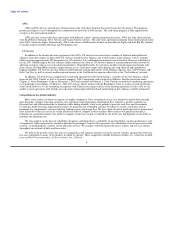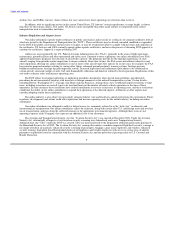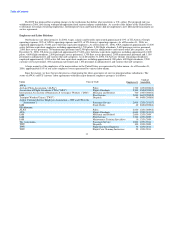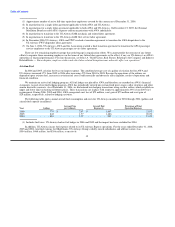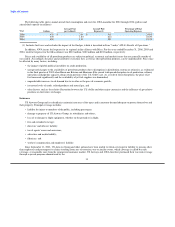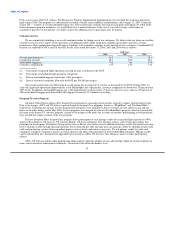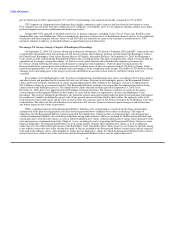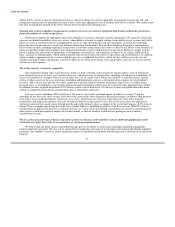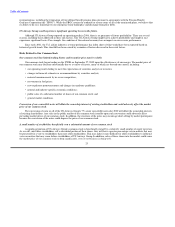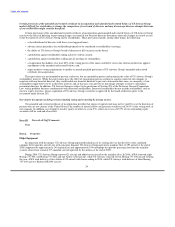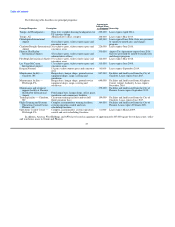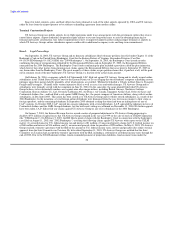US Airways 2006 Annual Report Download - page 21
Download and view the complete annual report
Please find page 21 of the 2006 US Airways annual report below. You can navigate through the pages in the report by either clicking on the pages listed below, or by using the keyword search tool below to find specific information within the annual report.
Table of Contents
Our ability to pay the fixed costs associated with our contractual obligations depends on our operating performance and cash flow,
which in turn depend on general economic and political conditions. A failure to pay our fixed costs or a breach of the contractual
obligations could result in a variety of adverse consequences, including the acceleration of our indebtedness, the withholding of credit
card proceeds by the credit card servicers and the exercise of remedies by our creditors and lessors. In such a situation, it is unlikely that
we would be able to fulfill our contractual obligations, repay the accelerated indebtedness, make required lease payments or otherwise
cover our fixed costs.
Union disputes, employee strikes and other labor-related disruptions may adversely affect our operations.
Relations between air carriers and labor unions in the United States are governed by the Railway Labor Act (the "RLA"). Under the
RLA, collective bargaining agreements generally contain "amendable dates" rather than expiration dates, and the RLA requires that a
carrier maintain the existing terms and conditions of employment following the amendable date through a multi-stage and usually lengthy
series of bargaining processes overseen by the National Mediation Board. This process continues until either the parties have reached
agreement on a new collective bargaining agreement, or the parties have been released to "self-help" by the National Mediation Board.
Although in most circumstances the RLA prohibits strikes, after release by the National Mediation Board carriers and unions are
free to engage in self-help measures such as strikes and lock-outs. None of the US Airways labor agreements becomes amendable until
December 31, 2009. Of the AWA labor agreements, four are currently amendable. There is also a risk that disgruntled employees, either
with or without union involvement, could engage in illegal slow-downs, work stoppages, partial work stoppages, sick-outs or other action
short of a full strike that could individually or collectively harm the operation of the airline and impair its financial performance. This risk
is heightened during our current negotiations for post-merger integrated labor agreements.
We rely heavily on automated systems to operate our business and any failure of these systems, or the failure to integrate them
successfully following the merger, could harm our business.
To operate our business, we depend on automated systems, including our computerized airline reservation systems, our flight
operations systems, our telecommunication systems and our websites. Our website and reservation systems must be able to accommodate
a high volume of traffic and deliver important flight information on a timely and reliable basis. Substantial or repeated website,
reservations systems or telecommunication systems failures could reduce the attractiveness of our services and could cause our customers
to purchase tickets from another airline.
Integration of automated airline systems is difficult, and we have encountered complications and difficulties in integrating some of
our automated systems and have not completed those integration efforts, including efforts to combine our two computerized airline
reservations systems. Any disruption in these systems could result in the loss of important data, increase our expenses and generally harm
our business, and any sustained disruption in these systems could have a material adverse effect on our business.
We might not be able to fully realize the synergies generated by the merger.
In deciding to enter into the merger agreement, US Airways Group and America West Holdings considered the long-term benefits
of operating as a combined company, including, among others, an enhanced ability to compete in the airline industry and the fact that the
proprietary brands of the combined company would permit US Airways Group to further differentiate itself from other airline companies.
The success of the merger depends, in part, on our ability to continue to realize the anticipated revenue opportunities and cost savings
from combining the businesses of US Airways Group and America West Holdings. We must continue to combine the businesses of
US Airways Group and America West Holdings in a manner that permits those costs savings and other synergies to be realized in a
timely fashion. In addition, we must achieve these savings without adversely affecting revenues or suffering a business interruption. If we
are not able to achieve these objectives, the anticipated long-term benefits of the merger may not be realized fully.
18


